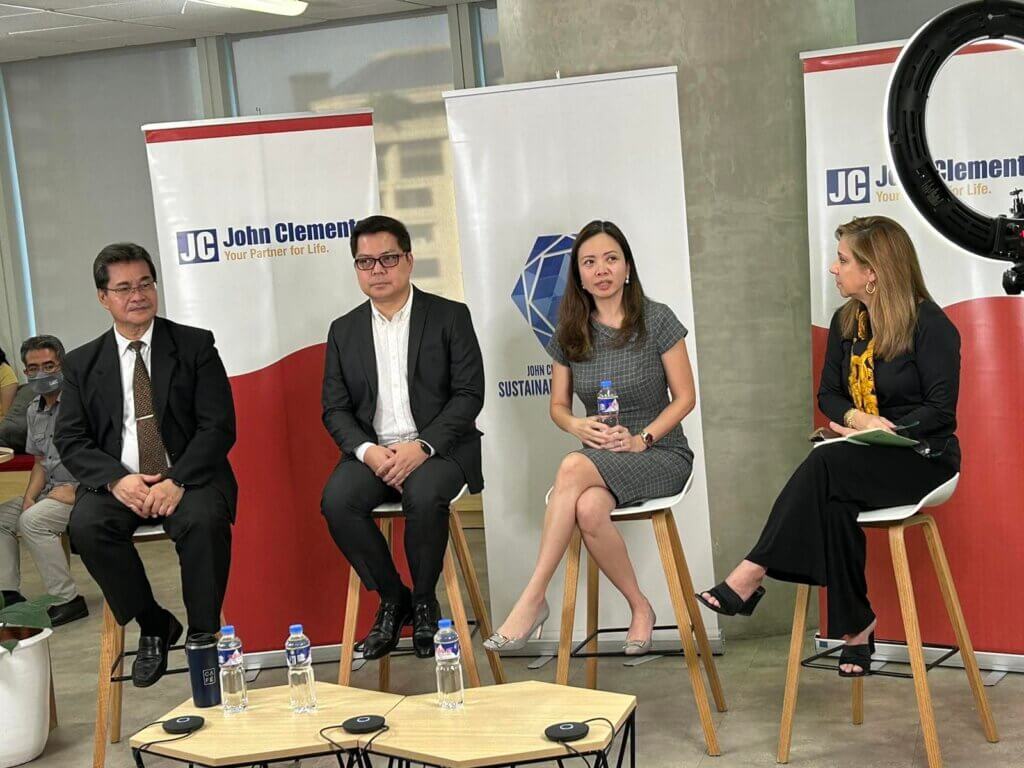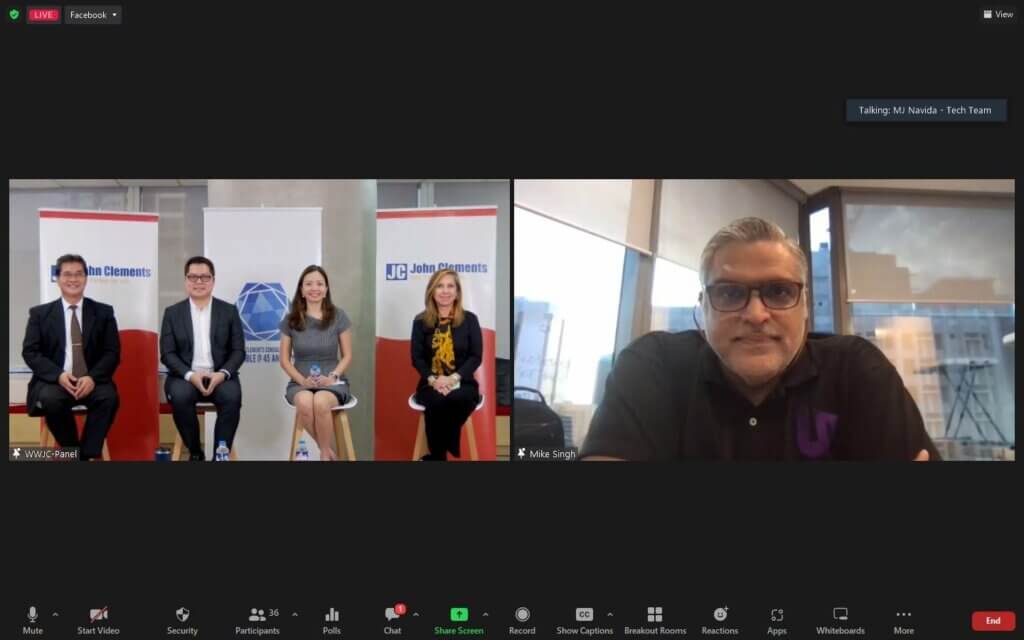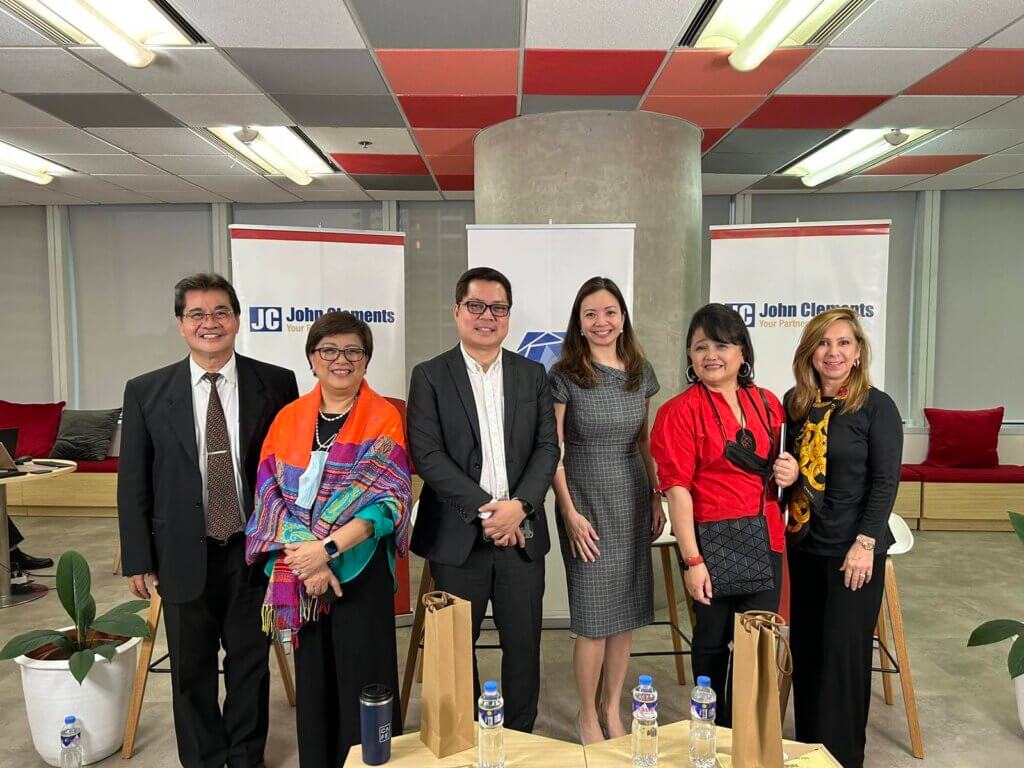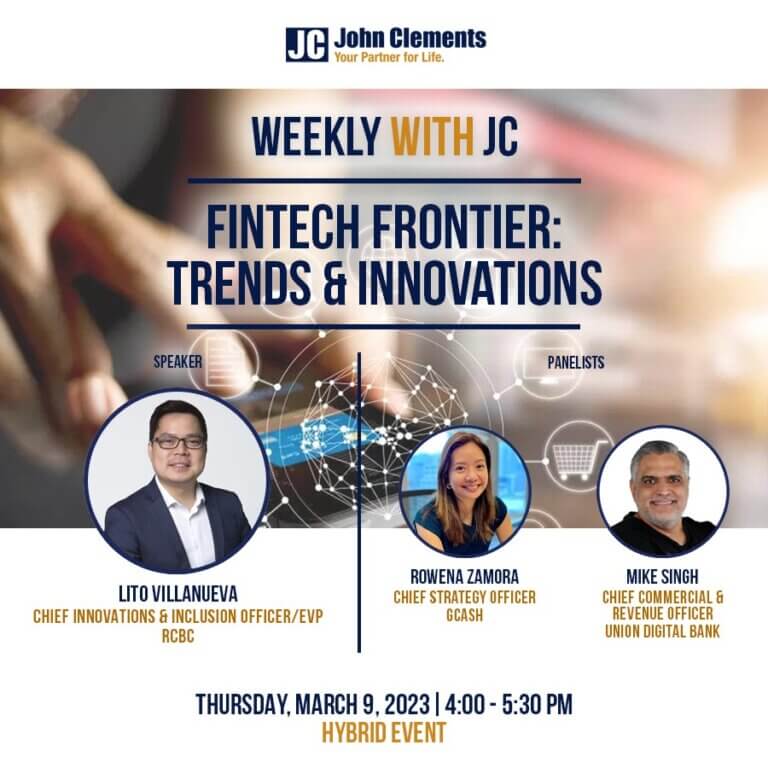“Who else here has no e-wallet app yet?” was the speaker’s trending question to attendees of a very interesting topic of Weekly with JC. The discussion on trends and innovations in the Philippine FinTech industry was led by Lito Villanueva, Chief Innovations & Inclusion Officer and EVP of RCBC. He was accompanied by panelists Rowena “Rowie” Zamora, Chief Strategy Officer of GCash, and Mike Singh, Chief Commercial and Revenue Officer of Union Digital Bank. This session was moderated by our very own Alexandra Lamb-Moran, Business Development Director of the John Clements Leadership Institute; and hosted by Mario Biscocho, Senior Vice President and Managing Director of John Clements’ Executive Search & Selection Division.

Lito Villanueva, the event’s main speaker, started his presentation with updates on the challenges brought about by the pandemic, citing health anxieties, constricting lockdowns, cost of livelihood, and lack of economic opportunities that crippled our capacity to hope and dream. Despite all this, Filipinos were hardly hopeless during those trying times and we had still seen a faint light at the end of the tunnel. One industry that shone brightly for many during the pandemic was the FinTech industry, a major pillar in the world’s path towards recovery. Despite mobility restrictions, it gave Filipinos access to telemedicine, remittances from loved ones, money transfers, insurance, loans, bills payment, cashless transactions, and funds disbursement through digital finance solutions and technological innovations. Indeed, the pandemic gave rise to innovative solutions that could stand the test of time. This was apparent, as shown in figures: in fact, in January 2023, Bangko Sentral ng Pilipinas (BSP) shared its confidence that we will achieve our collective vision of a digital Philippines this year. This means that 50% of retail payments will shift to digital, and 70% of adult Filipinos will be formally banked by the end of 2023, which used to be just wishful thinking years, even decades, prior.
Moreover, 30% of retail payments in 2021 have been attributed to digital transactions, an impressive growth from 20% in 2020. Evidently, we are slowly but surely embracing digitalization. When we purchase fast food or groceries, we can use handheld devices to tap our cards or scan QR codes. Over-the-counter payments also made QR codes available and customers now prefer to pay via e-wallets, predominantly led today by GCash. Here’s what is more promising, according to Mr. Villanueva: 56% of Filipinos were already banked in 2021, doubling the percentage of banked Filipinos in 2020. Moreover, the BSP’s InstaPay and PESOnet payment systems also grew exponentially in 2022, with a combined growth value of 37% or Php9.94 trillion, from just about Php7.24 trillion in 2021. The volume of transactions boomed to 633.45 million, from 523.61 million in 2021, which is equivalent to a 21% growth rate. These numbers tell us a story of diligence and ingenuity in the Philippine FinTech industry and the National Government. More importantly, this shows that Filipinos are more than ready to embrace digital, and we are just waiting for banks to engage with them and make digital banking systems accessible to all.
This progress would not have been possible without the support of our government leaders and regulators. Philippine President Bongbong Marcos has openly expressed his priority of expanding the country’s digital infrastructure. In his first state of the nation address, he highlighted the urgency of building a digital Philippines. This was followed by his investments in digitalized government services. In January 2023, he marked the E-Governance bill as an urgent matter. As of December 2022, 4,757 free Wi-Fi sites operated by the government have been made available to the public, giving 2.1 million Filipinos access to reliable and free internet. To FinTech, this means that more unreached and underserved Filipinos can now be reached. At the height of pandemic, FinTech became many Filipinos’ way to securely fulfill financial transactions at the safety and convenience of their own homes. The restrictions in movement and the fear of using cash have prompted many to explore the use of digital banks and e-wallets. Philippine consumer power was unlocked in 2022 with the lifting of many restrictions and the increase in vaccination rates. The economy grew by 7.5% because of these developments.

Growth in the country’s credit systems was also seen, which is good news. With increased accessibility in credit options for SMEs through digital, the Philippine FinTech industry provided the much-needed support for companies to recover, revive, and revamp their businesses post-pandemic. However, despite the growing trust and patronization from Filipinos, access to credit is still a challenge for 67% of mSMEs. The Philippine FinTech industry is already working tirelessly to address this huge need by integrating loan options and loan facilities into their systems.
Remittances are also a point of growth this year. In 2022, remittances reached USD36.14 billion from key sending markets. FinTech services started exploring ways to offer convenient and frictionless banking to families of OFWs.
Mr. Villanueva ended his presentation by stating that FinTech continues to be the lighthouse for many Filipinos slowly recovering from the effects of the pandemic. The gamble to offer alternative solutions to contemporary problems a decade ago has transformed cultures, reinvented lifestyles, and sheltered misconceptions. Through collaboration, diligence, creativity, and innovations with empathy, FinTech will continue to disperse light to everyone who needs it as they lead the way towards progress.
Rowena Zamora, one of the panelists, first shared what she thought about the evolving target of the BSP to set digital payments to 50%. She highlighted that, in that evolving target, we are not just talking about the 50% of payments that are set to be digital, but also about which of the changes that are happening around us could make this 50% target possible. We have regulatory considerations, technological considerations, internet penetration, mobile penetration. Having said that, the experience of the FinTech industry in urban areas would not be the same in terms of connectivity, and that impacts how they approach the said target in the space they are operating in.
Secondly, she also reacted about the access to credit, where the unbanked and underbanked are experiencing challenges in. This was due to the data requirements that formal lending institutions or formal banks require such as proof of identity or collaterals. Another point she touched on was FinTech innovations, and one of those innovations they launched in GCash is the trust score or credit score, called “GScore.” Traditionally, credit scoring is based on financial statements, history of borrowing and how responsible the borrower is in terms of paying. Now that most people transact digitally, digital behavior becomes a proxy for what a credit profile might be, especially one’s digital behavior in an e-wallet such as GCash.

Mike Singh, the second panelist, focused his points on data as currency and the value of credit in society. The World Bank says that there are four pillars of financial services that drive societies forward, and those are insurance, payment, savings, and credit. In an emerging market like the Philippines, where there is not a lot of recourse, it is a very difficult proposition to lend. And yet, credit is the absolute key for the Philippines to bring people up the financial services life cycle. The beauty about the FinTech space, where data as currency is being collected, is that it builds a credit score card that allows people to lend from mass markets in a more sustainable manner.

John Clements will be hosting another Weekly with JC event entitled “Watt’s Next? The Future of Renewable Energy” on April 13, 2023, which you can register for in-person or virtual attendance here.





